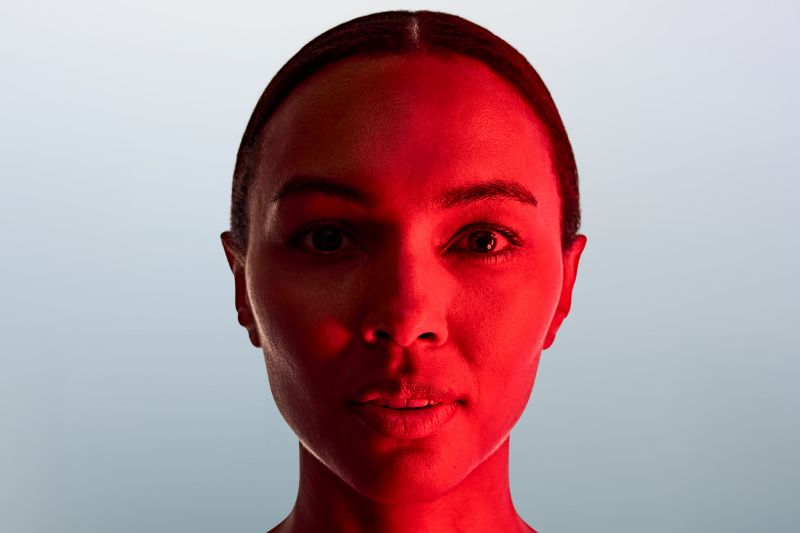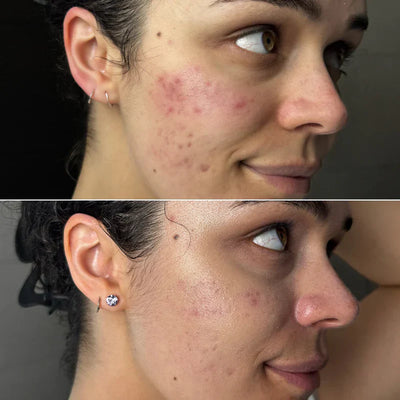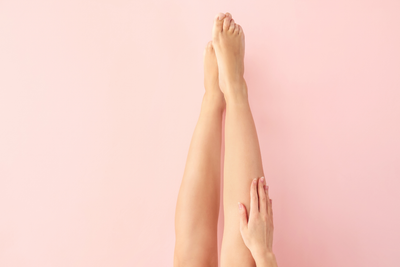Jump To
- What is LED therapy?
- What does LED therapy do?
- How does LED therapy work?
- What are the benefits of each LED light colour?
- What do LED light devices do for your skin?
- Does LED therapy actually work?
- How often should I use LED therapy at home?
- Is LED light safe?
- How long does it take to see results?
From results to risks, an expert reveals if this beauty tech really works.
From results to risks, an expert reveals if this beauty tech really works.
Of all the new skincare tech available to us today, red light therapy is arguably the most effective—and yet the most misunderstood.
Historically reserved for use behind the doors of high-end skincare specialists, this powerhouse treatment (in all device formats) can now be used from the comfort of your own home. But, with technology changing and—let’s be honest—the sometimes confusing terminology, it can be hard to know what’s right for you.
We asked Hafsa Issa-Salwe, an experienced aesthetician and facialist specialising in red light LED (light-emitting diode) therapy, to answer your most-asked questions when it comes to the basics of LED therapy. From its origins to the best way to use it, she discusses its efficacy and explains the benefits of each LED light colour.
What is LED therapy?
LED was initially developed by NASA, with the sole purpose of growing plants in space. LED technology has since ‘orbited’ from space stations to our earthly homes, emitting specific wavelengths that penetrate the skin’s layers and are absorbed by certain skin cells (as plants do when they absorb light to grow).
The light therapy has grown in popularity in recent years, with red and infrared wavelengths popular for anti-ageing due to their ability to energise cells and encourage collagen and elastin production, for smoother skin with fewer fine lines and wrinkles.
Meanwhile, research reveals that LED therapy stimulates cellular repair and minimises inflammation, even destroying blemish-causing bacteria and reducing oiliness.
What does LED therapy do?
When we think of beauty technologies used in-clinic, LED therapy is the first to come to mind due to its ability to tackle a number of skin concerns, including blemishes, dullness and redness, and reduce symptoms of inflammatory or autoimmune conditions such as rosacea, eczema or psoriasis. LED light can access various layers of the skin depending on the wavelength, making it a safe and versatile beauty solution.
How does LED therapy work?
LED therapy uses specific wavelengths to trigger reactions, or (in science speak) photo-biochemical reactions within cells. LED lights produce a range of different reactions within the skin, depending on the wavelength (or colour) used.

What are the benefits of each LED light colour?
Light exists on a spectrum, and LED light is no different. Each LED wavelength shows up as a different colour (except for near-infrared, which is clear), offering a range of unique benefits.
-
Blue (415nm) eliminates bacteria, reduces oil production and minimises shine, blackheads and clogged pores.
-
Green (532nm) decreases the activity of melanocyte cells responsible for producing melanin (naturally occurring pigment found in the skin), causing dark spots, hyperpigmentation and age spots.
-
Yellow (590nm) reduces inflammation, signs of oxidative stress and photoaging (sun damage).
-
Amber (605nm) calms redness and inflammation, evens skin tone, and reduces signs of photoaging (sun damage).
-
Red (633nm) increases the natural cellular energy (ATP), kickstarting cell regeneration, collagen, elastin and hyaluronic acid production, for plump, firm, smooth skin.
-
Red (640nm) improves cell oxygenation and helps keep hair follicles in the growth (anagen) phase for improved hair density.
-
Deep red (660nm) improves blood circulation and cell oxygenation, reducing inflammation, irritation and redness.
-
Near-infrared (830nm) accelerates cell repair, soothing redness and irritation while building strength for fragile skin conditions.
-
Deep near-infrared (1072nm) reaches even deeper into the skin to more effectively stimulate cell repair, wound healing and calm inflammation.
What do LED light devices do for your skin?
The best home-use LED devices use a combination of wavelengths to tackle the same skin concern at different levels. The CurrentBody Skin LED Light Therapy Mask: Series 2, for example, uses red (633nm) and near-infrared (830nm) light to focus on anti-ageing, targeting fine lines, wrinkles, skin elasticity and cell repair and hydration.
These wavelengths can be paired nicely with blue (415nm) light to minimise the redness, inflammation and irritation associated with eczema, dermatitis, rosacea and psoriasis.
For anyone dealing with breakouts rather than flare-ups or the visible signs of ageing, red (633nm) and blue (415nm) light make a great combination for treating mild to moderate acne. You’ll find this highly effective duo in the best-selling CurrentBody Skin LED Anti-Blemish Mask: Series 2.
Amber is a lesser-known (but still attention-worthy) colour, particularly at a wavelength of 605nm, perfect for addressing ageing concerns. Along with skin-soothing properties, amber also speeds up cell rejuvenation, collagen and elastin production. As our under eyes are one of the first places to show fine lines and wrinkles, the CurrentBody Skin LED Eye Mask is perfect for smoothing out fine lines before they become crow’s feet, brow 11’s or brow furrows, offering the full anti-ageing arsenal of amber, red, deep red and near-infrared.
Benefits like these are the reason I recommend at-home LED therapy to my clients. Not only to maintain in-clinic treatments, but also to enhance their results.

Does LED therapy actually work?
In one word: Yes. In my line of work, I’ve seen incredible transformations from LED therapy, but not all LED devices are created equal. Some fail to deliver the exact wavelengths needed for triggering cellular responses.
When looking for a good home-use LED device, the amount of light emitted from the bulbs really does matter. No matter how specific the wavelength, if the light intensity isn’t strong enough, then you just won’t get the same results.
How often should I use LED therapy at home?
Consistency is key with LED therapy.
When treating clients with problematic skin conditions like inflammatory acne, I advise daily use until their breakouts clear, then a couple of times per week to maintain results.
For anti-ageing and overall skin rejuvenation, I recommend three to five treatment sessions per week, although if you only have time for less, as long as you’re consistent, you’ll still achieve long-term results.
Is LED light safe?
Absolutely—LED is incredibly safe to use on almost all skin types and ages, and if there are any dangers, they’d usually only happen if you have a photosensitivity disorder. It’s worth noting that if you’re taking medication that increases your sensitivity to light, you might experience some side effects, such as burning or redness, so if you’re unsure, it’s best to check with your healthcare professional before starting treatment.
A lot of my clients ask me whether they can use LED therapy after Botox or fillers. My advice is always to wait for about two to four weeks before using LED to prevent any risk of filler migration or other complications, and if you’re coming out of surgery (whether for cosmetic purposes or a medical operation), LED can be your recovery partner to handle any bruising or swelling.
However, it’s best to avoid LED for at least twenty-four hours after a chemical peel, as the procedure leaves the skin so incredibly delicate.
How long does it take to see results?
All good things come to those who wait and are consistent. The speed at which you’ll see results all depends on how often you use LED and how severe your skin concern is. Moderate acne, wrinkles and an uneven skin texture will always take longer to tackle than mild acne and fine lines, but you should start to see improvements in a matter of weeks.
If you’re feeling impatient, it’s worth combining your at-home LED sessions with in-clinic appointments and a solid skincare routine. LED light and retinol go hand-in-hand (just not on the same day), along with antioxidants—these are all incredible at addressing signs of ageing. For my acne-prone clients, I recommend regular blue, red and near-infrared light treatments with an anti-inflammatory-focused skincare regime. They’ll often see results in just a couple of weeks.
The bottom line? When you add LED therapy into your beauty routine, you’re bound to see transformative results. There are only a few technologies on the market that do this, and that’s what makes LED stand out as one of the best ways to get great skin.



